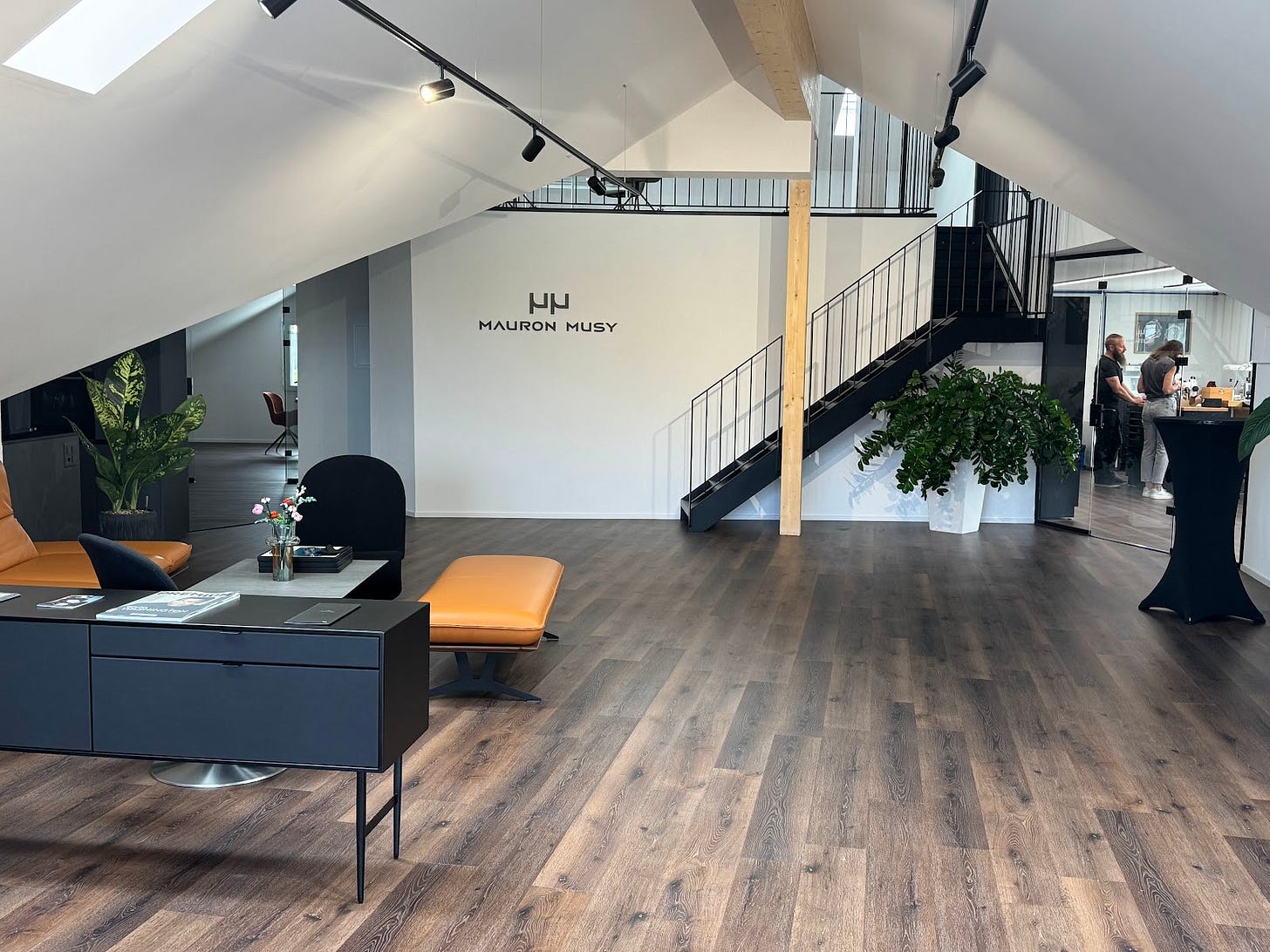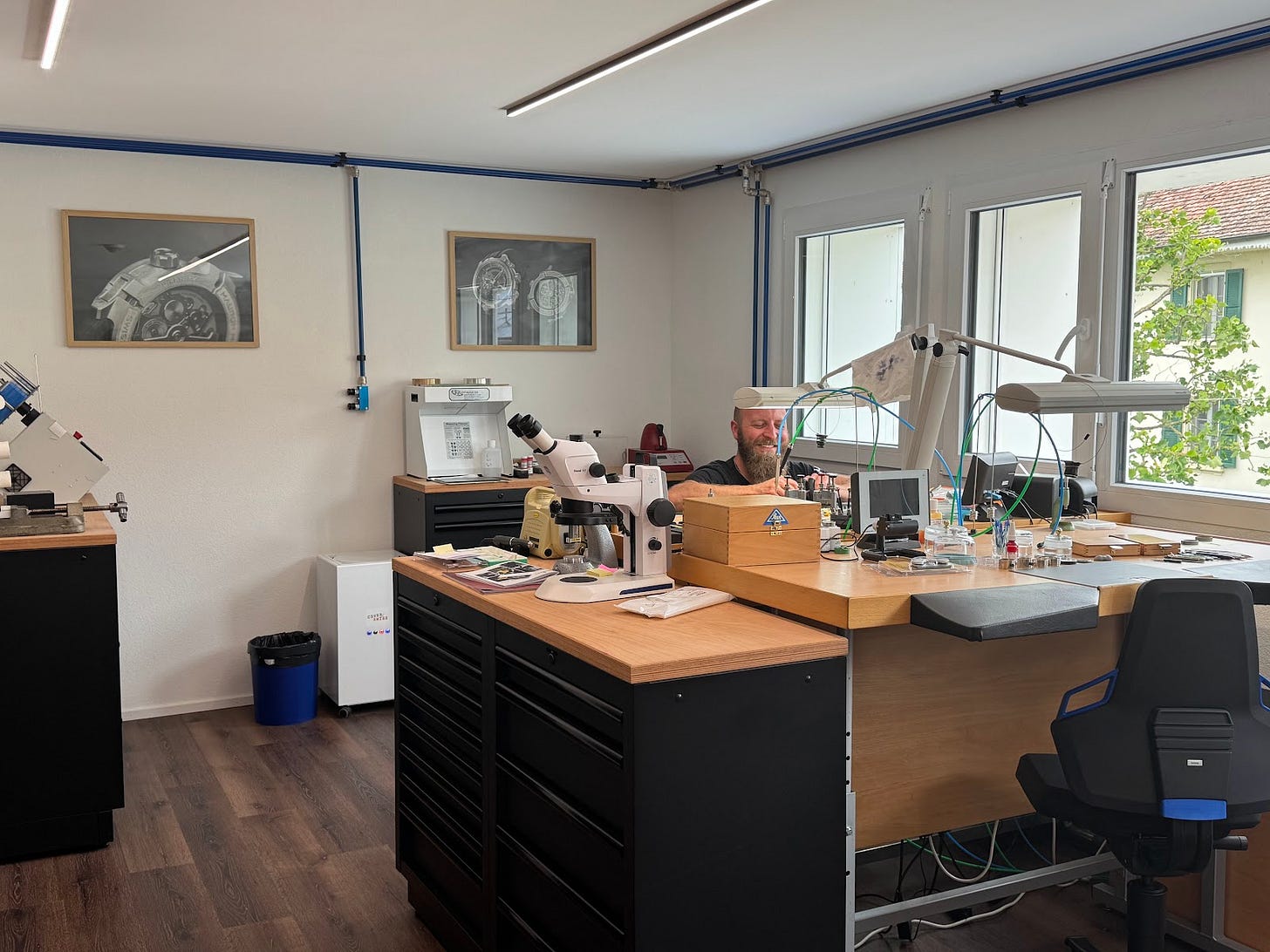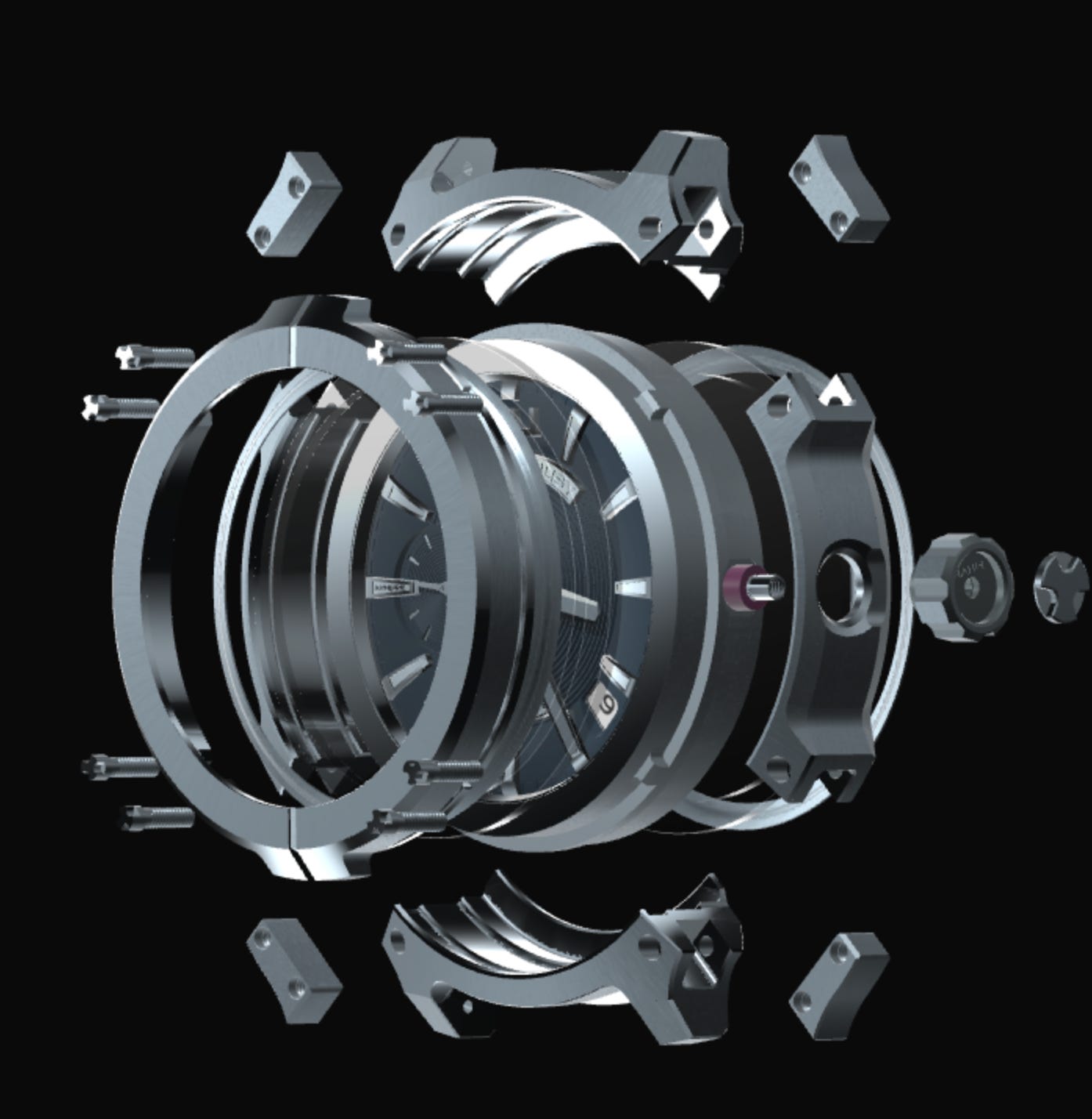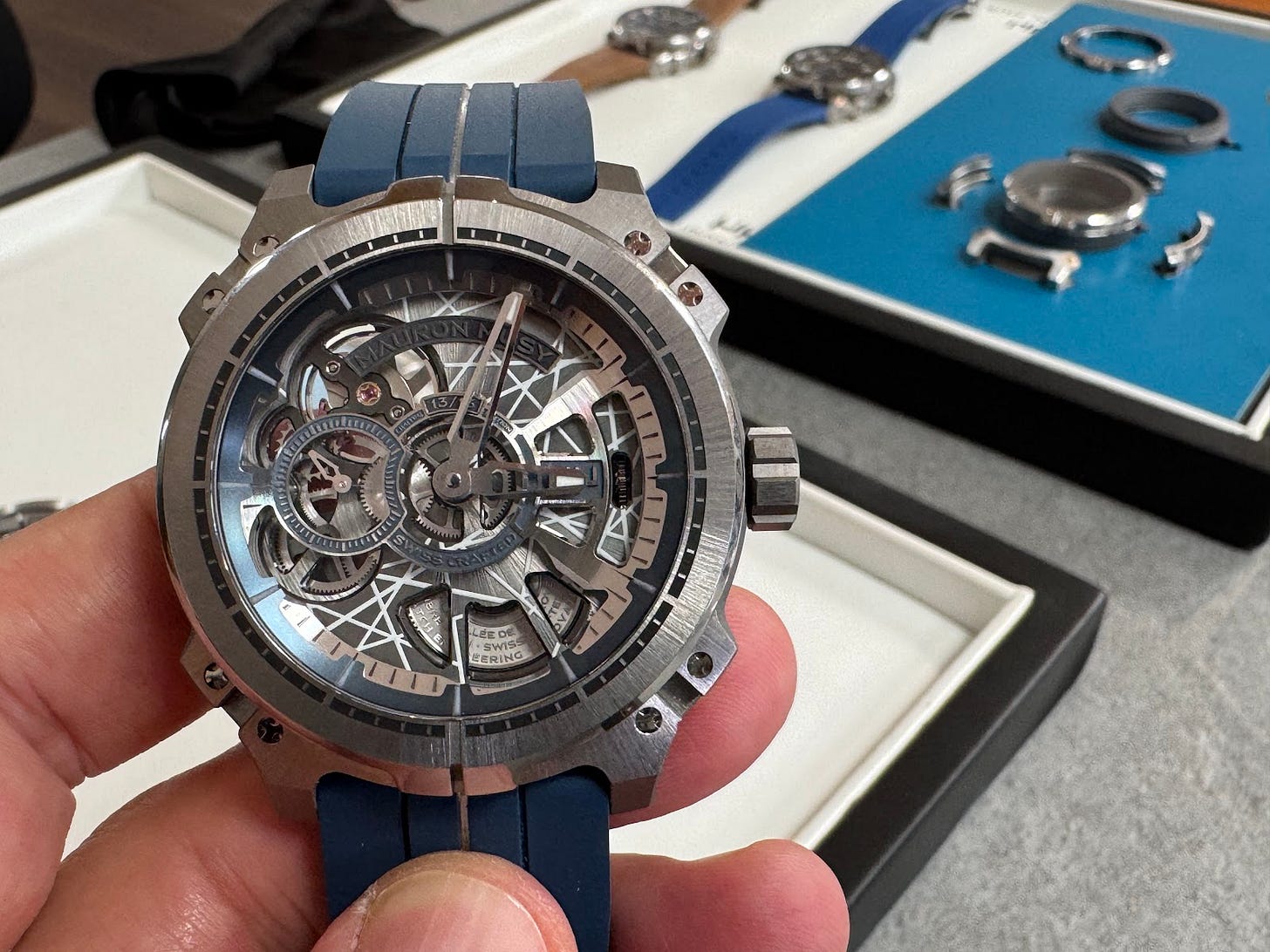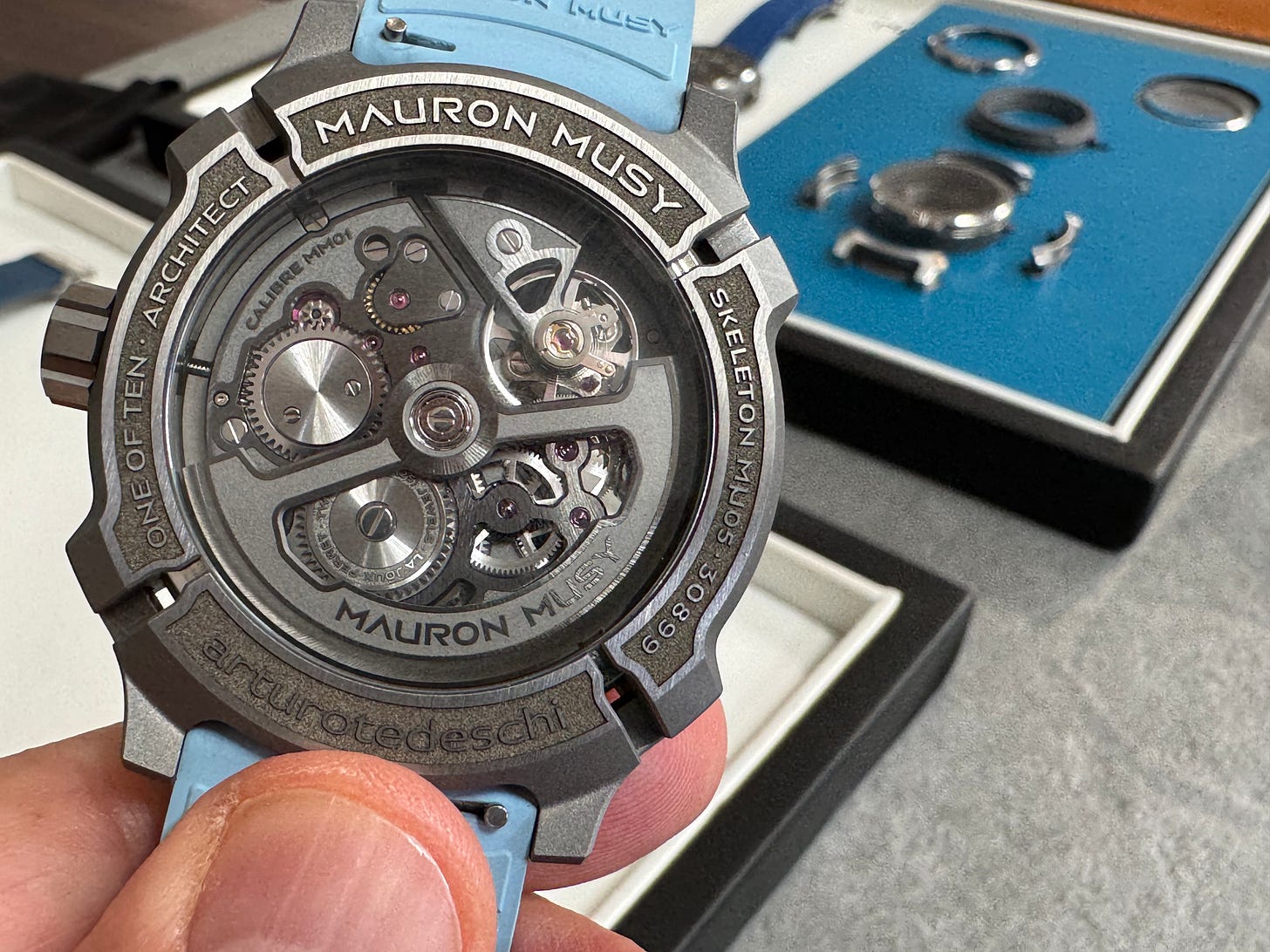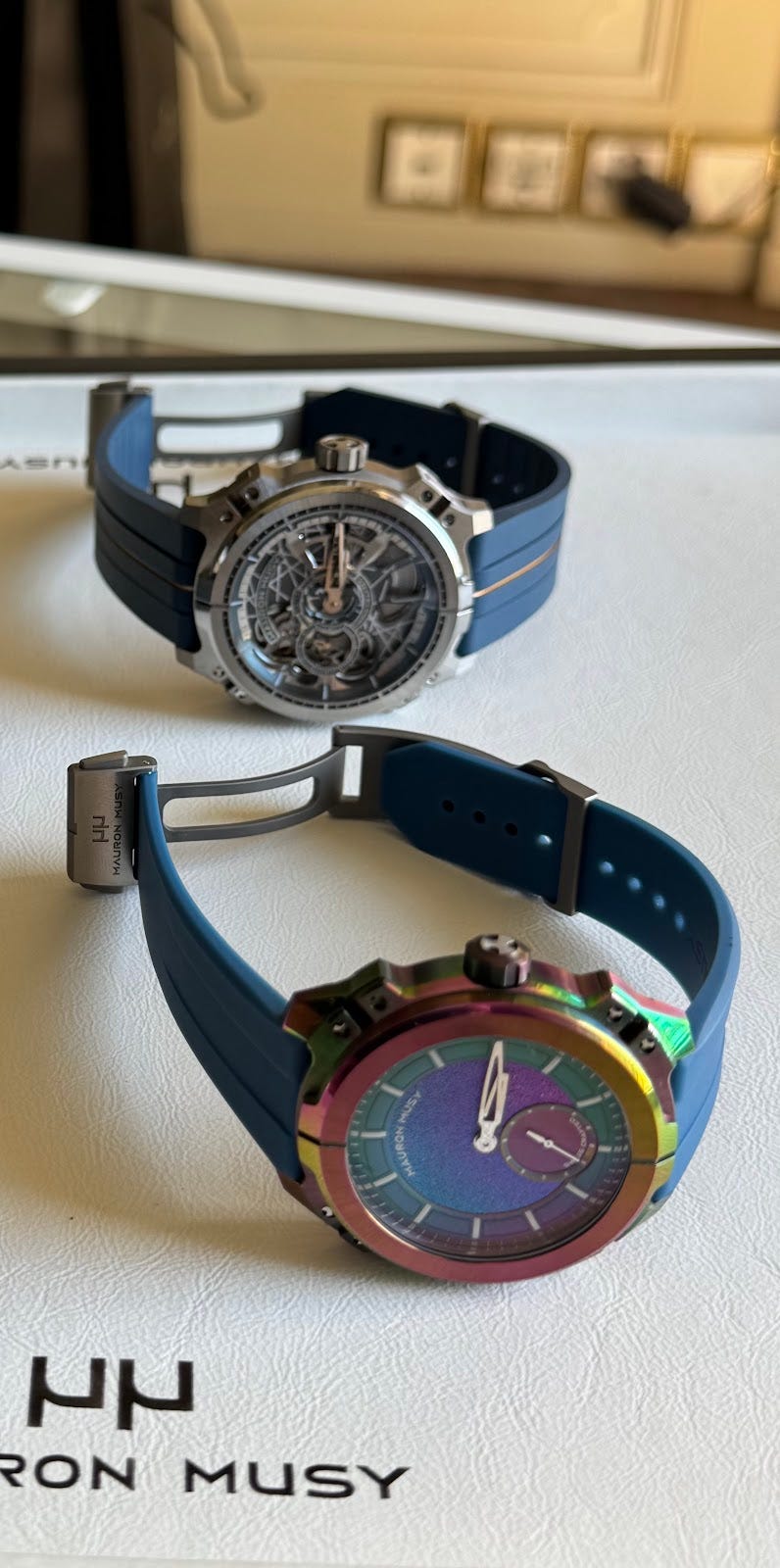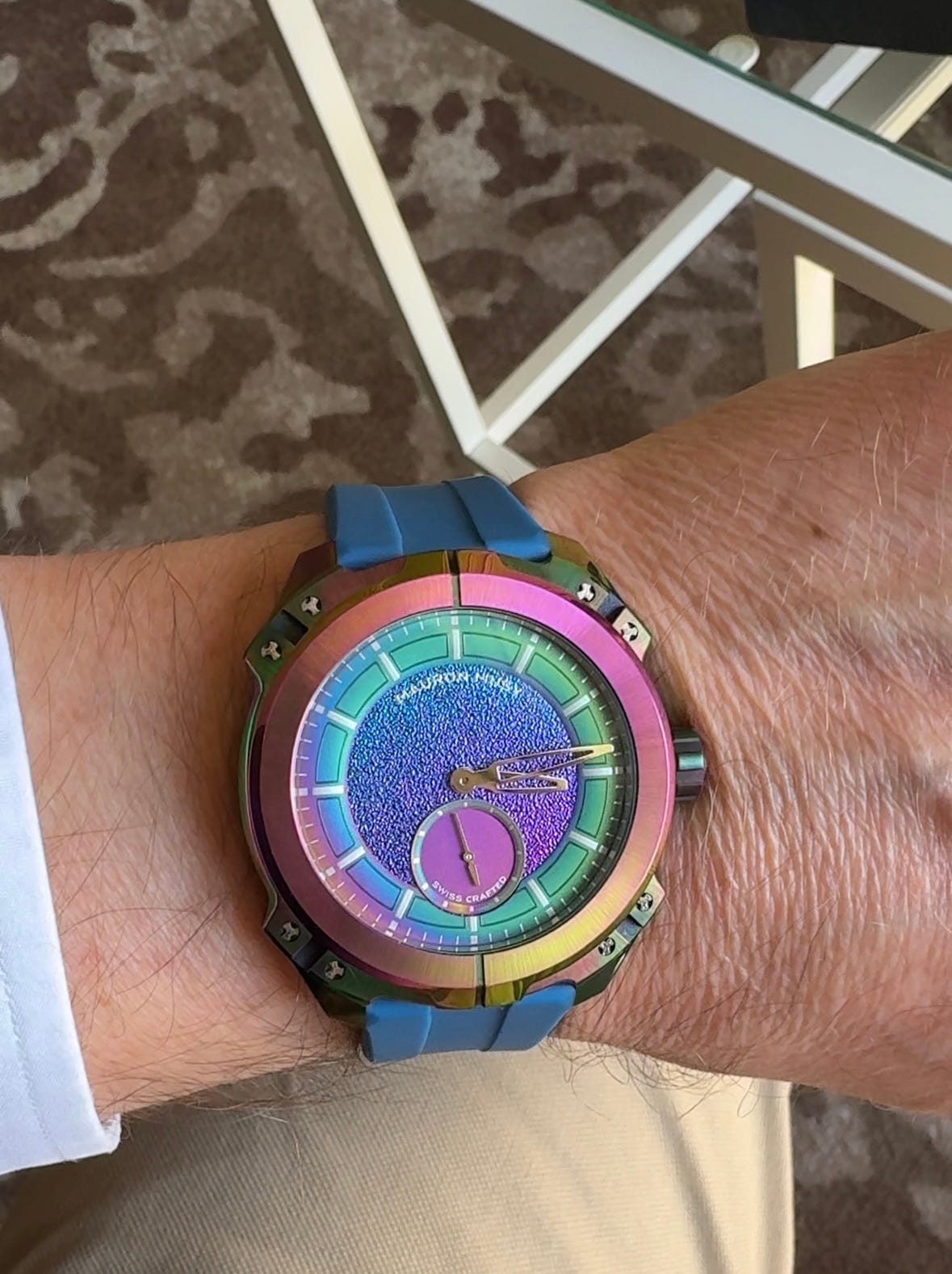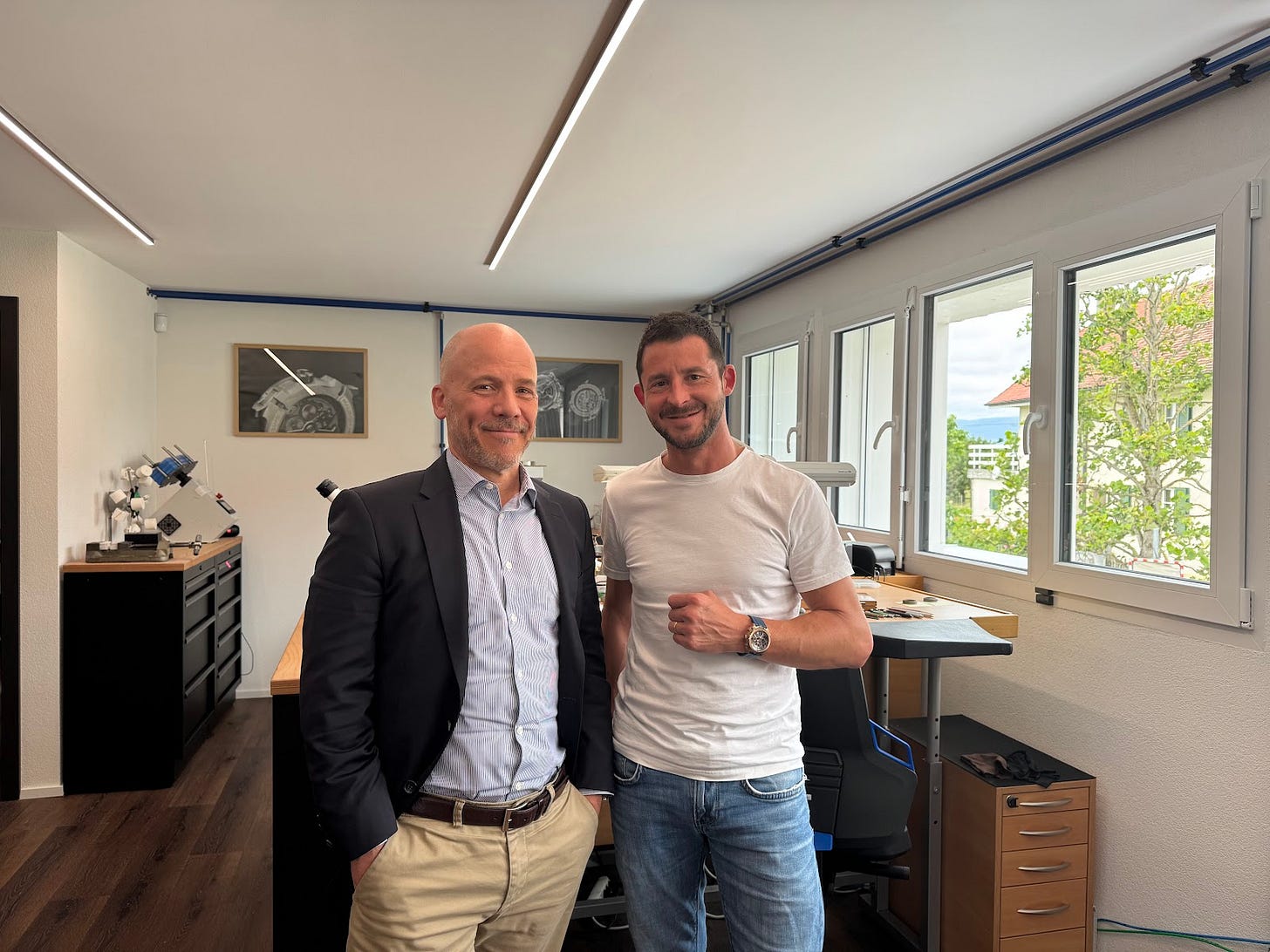The Implausible Seal: A Journey to Mauron Musy
On the shores of Lake Neuchâtel, Swiss manufacture Mauron Musy has spent the last decade solving a problem most watchmakers accept as inevitable: the need to replace rubber seals every few years.
The train to St-Aubin cuts through Swiss countryside with the mechanical precision of a good movement—reliable, predictable, faintly hypnotic. Outside the window, the Vallée de la Broye unfolds in that particular Swiss way: orderly farmland punctuated by clusters of buildings that look like they have been arranged by someone with strong opinions about property lines. I am carrying a notebook full of questions about gaskets, which feels appropriately absurd for a Tuesday morning in February.
Chemin du Carro 2, 1566 St-Aubin, Suisse. The address sits in my phone like a geographic coordinate to a very specific kind of obsession—the kind that makes a man spend three years eliminating rubber seals from mechanical watches because, in his words, the whole gasket-replacement cycle is "unnecessary."
The train's rhythm matches my skepticism. In an industry that reveres tradition with the devotion of a religious order, someone claiming to have solved a fundamental "problem" deserves the sort of cautious attention usually reserved for cure-all tonics and perpetual motion machines.
The Arrival
Marketing Manager Malika Brown greets me at the workshop with the kind of enthusiasm typically reserved for people who genuinely believe in what they are selling. She is wearing one of their 41mm pieces—a detail that will prove more significant than it initially appears. The building itself is modest by design: no marble lobbies or hushed reverence, just the functional aesthetic of people who make things with their hands (Fig. 1a; 1b).
"Would you like to see the first watches?" she asks, producing three pieces from 2016 with the care of someone handling historical artifacts. Which, in their particular universe, they are.
The evolution is immediately visible, even to the untrained eye. Steel cases with PVD coating give way to titanium; Eterna movements replaced by La Joux Perret collaborations; bezels that were once two parts becoming one. But the DNA—those four segments, that distinctive case architecture—was there from the beginning, like a genetic code that knew where it was heading.
"Co-founder Christophe Musy decided to go beyond Swiss-made," Malika explains, and there is something almost evangelical in her delivery. "He wanted to achieve Swiss-crafted, so 100% Swiss-made."
The distinction matters more than Swiss marketing law might suggest. While "Swiss made" requires only 60% of a watch's value to originate in Switzerland—a threshold that could theoretically be met by the balance wheel/hairspring system alone—Mauron Musy sources everything within a 60-kilometer radius. It is a philosophy that sounds almost quaint until you consider the practical implications: Christophe can literally drive to every supplier, shake hands, inspect operations, maintain control over a supply chain that fits within an afternoon's drive.
The Problem with Gaskets
The technical demonstration begins with the kind of matter-of-fact efficiency that suggests it has been performed many times before. Malika disassembles the watch with the casual confidence of someone demonstrating a particularly clever card trick, though what she is actually showing is the absence of something: no gaskets, no rubber seals, no elastic components waiting to deteriorate with time and temperature (Fig. 2a).
"A mechanical movement can work by itself," she explains, reassembling the components with practiced precision. "It is something that you can keep forever, pretty much. Yet every three to five years, you have to send your watch for service on the gaskets because the rubber gets dry and then it is not water-resistant anymore."
The nO-Ring® system—a name that manages to be both descriptive and oddly branded—replaces those doomed rubber components with what amounts to extremely precise machining. The case segments and sapphire crystal must be "extremely flat," she emphasizes, flat enough that metal-to-crystal contact creates a watertight seal without any intermediary material (Fig. 2b).
It is elegant in the way that good engineering often is: solving a complex problem by eliminating its fundamental cause rather than treating its symptoms. The skeptic in me wonders about long-term durability, about thermal expansion, about the countless variables that rubber gaskets were invented to accommodate. But the demonstration is compelling enough to suspend disbelief, at least temporarily.
The Materials Question
"We do not use steel anymore at all," Malika announces with the finality of someone discussing a resolved theological dispute. "Only titanium. We have bronze. We have hard gold." (Fig. 3a)
The material progression reveals the technology's deeper requirements. Grade 5 titanium is not chosen for its fashionable lightness or luxury positioning—though both are happy accidents—but because the nO-Ring® system demands materials hard enough to maintain precision under pressure. Regular gold would be "way too soft," requiring hardening treatments that transform a precious metal into something engineered for function rather than mere status.
It is a perfect example of form following function so completely that the aesthetic becomes almost incidental. The watches look the way they do because they have to, not because some designer decided brushed titanium was having a moment. (Fig. 3b)
Swiss Crafted vs. Swiss Made
The evolution from Eterna to La Joux Perret movements tells a story about compromises and principles. When Christophe realized Eterna could not deliver movement manufacturing that qualified as completely Swiss, he made what must have been an expensive decision: find partners who could.
"It was developed with them," Malika explains of the La Joux Perret collaboration. "They are the experts, right? But they made a movement for us, with us."
The distinction between "in-house" and "partnership" becomes almost philosophical at this level of collaboration. When Frédéric Jouvenot's micro rotor appears in their 41mm collection—his initials discretely inscribed on the movement—the question is not about manufacturing independence but about finding the right specialists for specific challenges.
It is a refreshingly honest approach in an industry that sometimes treats "manufacture" claims with the solemnity of papal declarations. Everyone, it seems, works with someone else. Even Laurent Ferrier, winner of last year’s Grand Prix d'Horlogerie de Genève (GPHG), uses specialized haut-de-gamme Swiss contractors. The difference lies in acknowledging it.
The Size Question
The transition from 44mm to 41mm cases reveals the technology's constraints with uncomfortable clarity. Water resistance drops from 300 meters to 100 meters because the sapphire crystal, necessarily thinner in the smaller case, cannot handle the same pressure. It is a reminder that even clever engineering has limits.
"If you make a smaller watch, then at some point you will have to have the thickness," Malika explains, gesturing to the substantial sapphire crystal. "It can become not so aesthetic."
The Panerai comparison is inevitable and instructive. When that brand introduced 40mm cases, something essential was lost—a lesson about the risks of chasing market trends when your core technology dictates certain proportions. Mauron Musy seems determined not to repeat that mistake, though market pressure for smaller watches continues to build.
The no-lug design helps with perceived size: a 44mm case wears more like 42mm, a clever bit of ergonomic sleight-of-hand that makes the technology's requirements more palatable to smaller wrists. Malika wears the 41mm comfortably, a living testament to the approach's success. (Fig. 4a)
The Demonstration Effect
Malika recalls a telling moment at Geneva. Potential retailers, dulled by endless presentations, showed the glazed politeness of people who had "seen I don't know how many watches that day."
"And then I show them this—I take the piece, disassemble it, then assemble it again. And the guys were really like, 'Wait, what? Really?' They got so excited."
It is the "wow moment"—that instant when abstract technology becomes tangible reality. Marketing materials and technical specifications pale beside the simple act of watching a timepiece come apart and go back together without revealing a single rubber gasket. The demonstration transforms skepticism into understanding, professional indifference into genuine curiosity.
The story suggests something important about how innovation actually spreads: not through elegant presentations or clever advertising, but through the accumulated force of small revelations, person by person, demonstration by demonstration: Diffusion.
The Independence Question
Mauron Musy produces between 200 and 250 watches annually, though their website mentions 600 as a goal—a discrepancy that Malika acknowledges with refreshing candor. The target represents aspiration; the reality reflects careful scaling.
"We really want to stick to that exclusivity and be able to be flexible with bespoke demands," she explains. "We don't want to take orders today and be able to deliver in three years."
It is a philosophy that puts customer experience ahead of growth metrics, though whether such restraint is sustainable remains an open question. The luxury market rewards scarcity, but only up to a point. Too little production and you risk irrelevance; too much and you sacrifice the exclusivity that justifies premium pricing.
The brand's solution involves careful geographic expansion—Japan, the Middle East, Switzerland, the UK currently, with the United States and Mexico planned for entry. It is methodical rather than aggressive, building depth before seeking breadth.
The Retail Reality
"We are not mainstream," Malika states with obvious pride. "We don't want to be in 50 different boutiques. We just have a few, the best ones."
The retail philosophy reflects both practical limitations and strategic positioning. Training multi-brand retailers to properly present the nO-Ring® technology requires significant investment—investment that only makes sense with carefully selected partners who can deliver the necessary demonstration expertise.
In French Switzerland, customers often prefer visiting the workshop directly, meeting Christophe, seeing the precision machinery downstairs. It is intimate brand building that would be impossible to replicate at scale, another argument for measured growth over aggressive expansion.
The Communication Strategy
Malika handles all public relations in-house, a detail that explains the authentic enthusiasm permeating every interaction. There is no agency filter, no carefully massaged messaging—just someone who genuinely believes in what they are selling and trusts the product to speak for itself.
"I'm pretty confident anyway," she says about sending watches to journalists without editorial control. "I don't need to tell people what to say."
It is either refreshing honesty or dangerous naivety, depending on your perspective. In an industry where control over messaging often takes precedence over authentic communication, the approach feels almost subversive.
The Complications Question
Future development focuses on practical additions rather than horological showmanship. A chronograph is planned for 2028, built on a new movement collaboration with TELOS, a Swiss watchmaking company specializing in high-end watch development and manufacturing.
"For us, maybe not right now" is Malika's response to minute repeaters, though she notes the interesting possibility of licensing the pusher technology to brands specializing in such complications. Removing gaskets would actually improve sound transmission—a delicious irony that traditional minute repeater specialists might find compelling.
The development timeline suggests patient ambition: new movement in 2026 with 100+ hour power reserve, chronograph implementation by 2028. It is a methodical progression that prioritizes engineering excellence over market pressure for rapid innovation.
The Bespoke Reality
Custom work happens "full speed," according to Malika, with frequent requests for personalized engravings, specific dial colors, or custom numbering. Recent examples include a customer who wanted his name instead of the limited edition number—a simple change that transforms a collectible into something genuinely personal.
Limited editions typically comprise 13 pieces, a number chosen for multiple symbolic reasons: Christophe's lucky number, the year development began (2013), the 13th letter of the alphabet (M for Mauron Musy). It is the kind of layered meaning that feels either deeply considered or cleverly rationalized after the fact.
Gold pieces are limited to eight examples for even greater exclusivity—a level of scarcity that borders on the theoretical for most potential customers.
The Philosophy Question
The contrast with Patek Philippe's inheritance messaging could not be sharper. Where the Geneva giant promotes watches "you never actually own" but merely hold for the next generation, Mauron Musy explicitly wants theirs worn daily.
"We want people who wear the Mauron Musy and many people wear them on a daily basis," Christophe explains when he briefly joins our conversation. "There is good comfort, it's solid, it's durable, it's long-lasting."
It is a fundamental philosophical difference disguised as marketing strategy. One approach treats watches as heirlooms-in-waiting, preserved for future appreciation. The other embraces them as tools for present enjoyment, designed to improve rather than complicate the wearing experience.
The nO-Ring® system enables this philosophy by eliminating the service anxiety that discourages daily wear. No more mental calculations about when the last gasket service occurred, no more reluctance to expose the watch to moisture or temperature changes.
The Industry Perspective
Christophe sees independent brands not as competitors to established giants but as complementary forces in a healthy ecosystem. "We need their visibility to make watchmaking shine," he argues. "They bring all this visibility and importance to watchmaking."
It is a generous perspective that recognizes economic reality: independent brands benefit from the market awareness created by major players, even as they serve different customer needs. The symbiosis works as long as both sides maintain their respective strengths.
The comment reveals confidence in the brand's unique positioning. When your primary competitive advantage involves solving a problem that affects the entire industry, competition looks different than when you are fighting over market share in crowded segments.
The Return Journey
The train back to Zurich carries me through the same orderly landscape, but my perspective has shifted in ways both subtle and significant. The notebook now contains not just answers to prepared questions but the fragments of a larger story about innovation, philosophy, and the curious persistence of small obsessions.
The analytical part of me wonders about the long-term implications of such precision-dependent engineering. Rubber seals, for all their eventual deterioration, accommodate thermal expansion, manufacturing tolerances, and the countless small variables that characterize decades of real-world use. Mauron Musy's approach demands exceptional consistency—a bet on Swiss precision manufacturing that feels both ambitious and entirely appropriate for a brand willing to source everything within a 60-kilometer radius.
Yet the demonstration was undeniably compelling. Watching those case segments align with mechanical precision, creating watertight seals through nothing but extremely flat surfaces, suggested possibilities beyond the incremental improvements that typically characterize horological "innovation."
More intriguing than the technology itself is the philosophy surrounding it: the commitment to local manufacturing, the emphasis on daily wear over ceremonial preservation, the patient approach to scaling that prioritizes customer experience over growth metrics. In an industry often criticized for prioritizing heritage over innovation, tradition over utility, Mauron Musy represents something genuinely different.
Whether that difference proves sustainable remains an open question. The luxury market has its own logic, its own demands, its own ways of testing good intentions against commercial reality. But for now, in this particular corner of the Vallée de la Broye, someone has built something genuinely different and invited the world to take notice.
The train pulls into Zurich with the same mechanical precision it displayed on the outbound journey. My watch—a conventional piece with conventional gaskets—continues marking time with conventional reliability. But the questions linger: What if gasket service really is unnecessary? What if daily wear truly is preferable to preservation? What if the last service has already happened?
But that's another story for another train. (Fig. 5)
Author: Sergio Galanti



